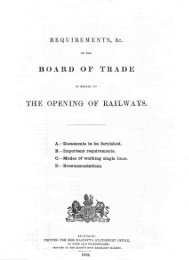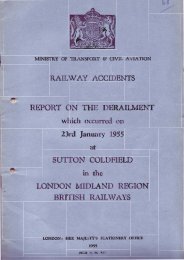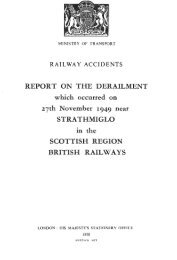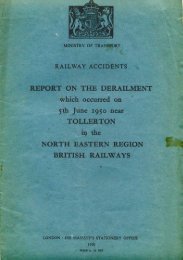R A I LT R AC K - The Railways Archive
R A I LT R AC K - The Railways Archive
R A I LT R AC K - The Railways Archive
Create successful ePaper yourself
Turn your PDF publications into a flip-book with our unique Google optimized e-Paper software.
H e a t h r ow Express commenced services to and from<br />
London Paddington in 1998 and we are curr e n t ly wo rking with<br />
a number of parties to develop infra s t ructure for access from<br />
St Pa n c ra s ,and to provide a new southern link.<br />
In 1998, a regular hourly service was introduced from Stansted<br />
A i rp o rt to Cambridge and the Midlands, while additional peak<br />
s e rvices and services calling at intermediate stations we r e<br />
introduced from London's Live rpool Street Station.<br />
At Luton, we are currently building a new station that<br />
will fulfil a dual role as both a parkway station and a facility<br />
for easy access to the airport.Much of the infrastructure<br />
works are now complete.We expect services to commence<br />
during the second half of 1999.<br />
Manchester Airport. <strong>The</strong> rail link to Manchester Airpor t<br />
has developed business successfully since its opening in 1993.<br />
Manchester Airport's second runway is now under<br />
construction. We are addressing options for how future<br />
growth can best be met as part of our overall strategy to<br />
improve capacity in and around Manchester, which we set<br />
out later in this section.<br />
Glasgow Airport. We are working with Strathclyde<br />
Passenger Transport Executive (PTE) to assess the options<br />
for providing a rail link from the airport to Paisley and<br />
central Glasgow.<br />
Birmingham Airport. We are working with a number of<br />
parties including Birmingham International Airport,<br />
Birmingham City Council,the National Exhibition Centre and<br />
West Midlands Passenger Transport Authority (Centro) on<br />
plans to radically improve the facilities focused around<br />
Birmingham International Station.<br />
Irish sea ports. <strong>The</strong> development of faster and higher<br />
capacity ferries has helped to stimulate demand for rail/sea<br />
journeys between Ireland and Great Britain.At Holyhead, we<br />
are completing the station regeneration works to<br />
complement the new terminal facilities provided by the port.<br />
Channel Tunnel Rail Link<br />
We have begun construction of the new high-speed link<br />
between London and the Channel Tunnel. More information<br />
is given in Route Strategies 6 and 18.<br />
6.2 Passenger market growth<br />
6.2<br />
<strong>The</strong> starting point for developing and enhancing the network<br />
is the ability to forecast demand and to understand how<br />
train operators would react to this demand. Possible<br />
reactions to demand growth include increasing the number<br />
of seats filled on existing trains,lengthening existing trains or<br />
running more trains.<br />
We have four principal sources of information on which to<br />
base our forecasts of market growth.<br />
• First, we place considerable weight on what we learn<br />
from passenger and freight operating companies.<strong>The</strong><br />
recent customer-reasonable requirements process has<br />
helped with this.Our customers are carrying the risks of<br />
the short-term end-market demand in their own<br />
business plans,with the Franchising Director taking the<br />
long-term demand risk.Revenue sharing arrangements<br />
such as those we have with Virgin Rail Group and<br />
Chiltern <strong>Railways</strong> bring us closer to a shared<br />
understanding of some end markets.<br />
Our market growth assumptions include the effects<br />
of additional train services resulting from the<br />
implementation of Moderation of Competition<br />
(Stage 2) provisions in so far as our customers have<br />
discussed their plans with us.<br />
• Second,as an operator of 14 major stations, we carry<br />
out independent market research among customers and<br />
listen to the needs of our retailing partners at these<br />
locations.<strong>The</strong> output of this research feeds into the<br />
development plans described in the relevant route<br />
sections of this document.<br />
• Third, we have developed our own passenger-demand<br />
forecasting tools to assist with modelling future demand,<br />
and to anticipate likely changes required in network<br />
capacity and capability. An equilibrium econometric<br />
model of the Great Britain passenger transport market<br />
developed for us by the Centre for Economic and<br />
Business Research is the centrepiece of this.<br />
• Fourth, we have begun to assess the implications of the<br />
Government's Integrated Transport Policy for changes in<br />
demand for capacity which might be brought about<br />
either directly by the public sector through<br />
reprioritisation of investment expenditure, or through<br />
the market responding to changes in the structure of<br />
charges for the use of different modes of transport.<br />
Rail has been losing mar ket share for much of the 20th<br />
<strong>The</strong> starting point<br />
for developing and<br />
enhancing the<br />
network is the ability<br />
to forecast demand<br />
and to understand<br />
how train operators<br />
would react to this<br />
demand<br />
63








